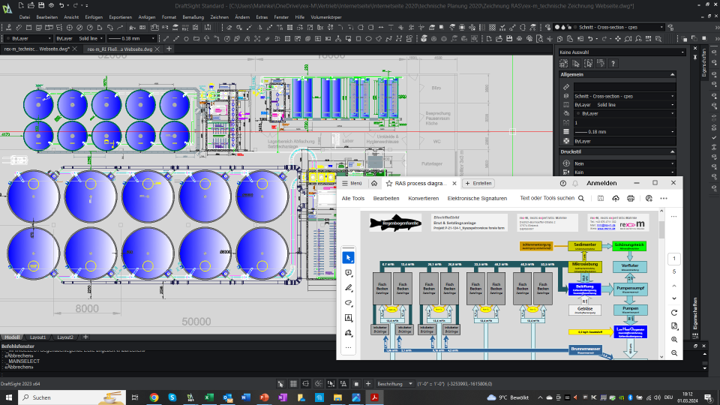As part of the technical planning of RAS, I develop system descriptions, process diagrams, detailed technical drawings and extensive tabular overviews. My specification includes manufacturers, prices, dimensions, connections, capacity, performance, hydraulics and consumption. In summary I show the capital expenditure and the operating costs.

An aquaculture system is made up of the habitat, water recirculation and water treatment. The process technology consists of machines, tanks, basin installations, pipelines and biofilter material. The calculation particularly is based in fish feed amount and water recirculation.
Fish tanks
Round, square, rectangular or D-ended tanks are used for rearing up to fingerlings. These tanks are flushed or drained using a telescopic outlet. The self-cleaning action of circular tanks is based on the so-called “tea-cup effect”. For large tanks I use the “Cornell Dual Drain” design. A smaller part of of the runoff is routed via the floor drain, but the main part via the side wall drain. With the help of separation grids and quiescent zones raceways are divided into separate sections. While most species of sturgeon clean the channels on their own, adequate flow speeds must be used for farming trout.

Water treatment
Microscreen drum filters remove large suspended solids from the water. In the context of end-of-pipe treatment the backwash water of the drum filter should be treated separately from the clear water overflow. In my RAS design fine suspended solids will be controlled in submerged fixed bed bio reactors (FBBR) with down-stream trickling filter degassing.
Bacteria will be reduced by the exposure to UV-light. Closed UV reactors will be integrated in the piping of small-scale RAS. For large flow rates open channel UV systems find a use in my RAS design. I use ozone for RAS with denitrification. In addition to reducing germs, ozone breaks down organic compounds such as yellow substances, which visibly reduces water turbidity.

In the biofilter, bacteria convert fish-toxic ammonia into harmless nitrate. For nitrification and degassing I apply mainly self-cleaning moving bed bio reactors (MBBR). The pH value drops as a result of nitrification. PH will be adjusted by demand-actuated dosing of alkaline substances in form of lime and soda. Nitrate either can be thinned out or can be reduced by bacterial denitrification. Denitrifying bacteria must be fed with carbonic, organic compounds in the form of molasses or ethanol.
Aeration supplies fish and bacteria with oxygen and degasses unwanted gases as carbon dioxide. My aquaculture systems combine compressed air ventilation, trickling towers and oxygenation. I make use of low-head oxygenation or pressure-free, mechanical oxygenators. Emergency oxygenation must start automatically in case of dysfunctions.

Water recirculation
My large-scale RAS are characterized by low-head design and application of vertical propeller pumps. Raceway systems are equipped with horizontal propeller pumps and/or with mammoth pumps for hydro-pneumatic water transport. Submersible pumps and dry positioned pumps are utilized for medium-head applications in small-scale aquaculture systems and for bypass-filter. High-pressure pumps are utilized for injection of ozone and backwashing of drum filters.
PVC pressure pipes up to nominal size DN250 are suitable to transport water and air. PVC sewage pipes are available up to DN500. For water applications of larger nominal diameters I plan pipes made from polyethylene or channels.

